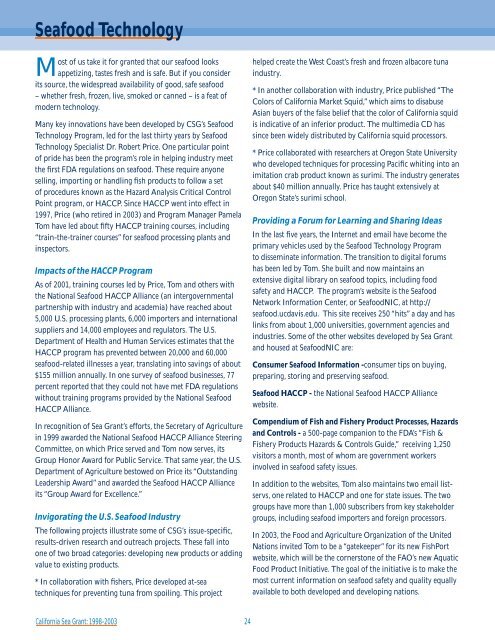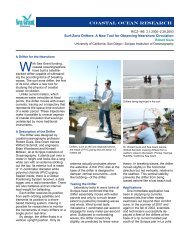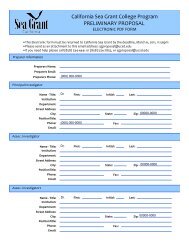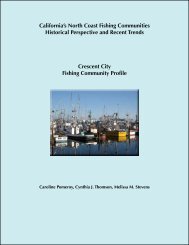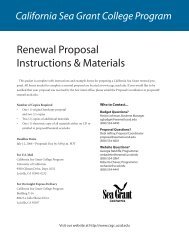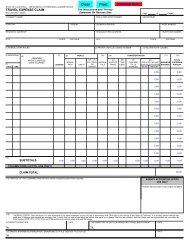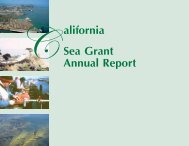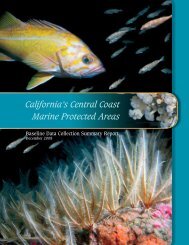PAT-UC Covers - California Sea Grant - UC San Diego
PAT-UC Covers - California Sea Grant - UC San Diego
PAT-UC Covers - California Sea Grant - UC San Diego
Create successful ePaper yourself
Turn your PDF publications into a flip-book with our unique Google optimized e-Paper software.
<strong>Sea</strong>food Technology<br />
Most of us take it for granted that our seafood looks<br />
appetizing, tastes fresh and is safe. But if you consider<br />
its source, the widespread availability of good, safe seafood<br />
– whether fresh, frozen, live, smoked or canned – is a feat of<br />
modern technology.<br />
Many key innovations have been developed by CSG’s <strong>Sea</strong>food<br />
Technology Program, led for the last thirty years by <strong>Sea</strong>food<br />
Technology Specialist Dr. Robert Price. One particular point<br />
of pride has been the program’s role in helping industry meet<br />
the first FDA regulations on seafood. These require anyone<br />
selling, importing or handling fish products to follow a set<br />
of procedures known as the Hazard Analysis Critical Control<br />
Point program, or HACCP. Since HACCP went into effect in<br />
1997, Price (who retired in 2003) and Program Manager Pamela<br />
Tom have led about fifty HACCP training courses, including<br />
“train-the-trainer courses” for seafood processing plants and<br />
inspectors.<br />
Impacts of the HACCP Program<br />
As of 2001, training courses led by Price, Tom and others with<br />
the National <strong>Sea</strong>food HACCP Alliance (an intergovernmental<br />
partnership with industry and academia) have reached about<br />
5,000 U.S. processing plants, 6,000 importers and international<br />
suppliers and 14,000 employees and regulators. The U.S.<br />
Department of Health and Human Services estimates that the<br />
HACCP program has prevented between 20,000 and 60,000<br />
seafood-related illnesses a year, translating into savings of about<br />
$155 million annually. In one survey of seafood businesses, 77<br />
percent reported that they could not have met FDA regulations<br />
without training programs provided by the National <strong>Sea</strong>food<br />
HACCP Alliance.<br />
In recognition of <strong>Sea</strong> <strong>Grant</strong>’s efforts, the Secretary of Agriculture<br />
in 1999 awarded the National <strong>Sea</strong>food HACCP Alliance Steering<br />
Committee, on which Price served and Tom now serves, its<br />
Group Honor Award for Public Service. That same year, the U.S.<br />
Department of Agriculture bestowed on Price its “Outstanding<br />
Leadership Award” and awarded the <strong>Sea</strong>food HACCP Alliance<br />
its “Group Award for Excellence.”<br />
Invigorating the U.S. <strong>Sea</strong>food Industry<br />
The following projects illustrate some of CSG’s issue-specific,<br />
results-driven research and outreach projects. These fall into<br />
one of two broad categories: developing new products or adding<br />
value to existing products.<br />
* In collaboration with fishers, Price developed at-sea<br />
techniques for preventing tuna from spoiling. This project<br />
helped create the West Coast’s fresh and frozen albacore tuna<br />
industry.<br />
* In another collaboration with industry, Price published “The<br />
Colors of <strong>California</strong> Market Squid,” which aims to disabuse<br />
Asian buyers of the false belief that the color of <strong>California</strong> squid<br />
is indicative of an inferior product. The multimedia CD has<br />
since been widely distributed by <strong>California</strong> squid processors.<br />
* Price collaborated with researchers at Oregon State University<br />
who developed techniques for processing Pacific whiting into an<br />
imitation crab product known as surimi. The industry generates<br />
about $40 million annually. Price has taught extensively at<br />
Oregon State’s surimi school.<br />
Providing a Forum for Learning and Sharing Ideas<br />
In the last five years, the Internet and email have become the<br />
primary vehicles used by the <strong>Sea</strong>food Technology Program<br />
to disseminate information. The transition to digital forums<br />
has been led by Tom. She built and now maintains an<br />
extensive digital library on seafood topics, including food<br />
safety and HACCP. The program’s website is the <strong>Sea</strong>food<br />
Network Information Center, or <strong>Sea</strong>foodNIC, at http://<br />
seafood.ucdavis.edu. This site receives 250 “hits” a day and has<br />
links from about 1,000 universities, government agencies and<br />
industries. Some of the other websites developed by <strong>Sea</strong> <strong>Grant</strong><br />
and housed at <strong>Sea</strong>foodNIC are:<br />
Consumer <strong>Sea</strong>food Information -consumer tips on buying,<br />
preparing, storing and preserving seafood.<br />
<strong>Sea</strong>food HACCP - the National <strong>Sea</strong>food HACCP Alliance<br />
website.<br />
Compendium of Fish and Fishery Product Processes, Hazards<br />
and Controls - a 500-page companion to the FDA’s “Fish &<br />
Fishery Products Hazards & Controls Guide,” receiving 1,250<br />
visitors a month, most of whom are government workers<br />
involved in seafood safety issues.<br />
In addition to the websites, Tom also maintains two email listservs,<br />
one related to HACCP and one for state issues. The two<br />
groups have more than 1,000 subscribers from key stakeholder<br />
groups, including seafood importers and foreign processors.<br />
In 2003, the Food and Agriculture Organization of the United<br />
Nations invited Tom to be a “gatekeeper” for its new FishPort<br />
website, which will be the cornerstone of the FAO’s new Aquatic<br />
Food Product Initiative. The goal of the initiative is to make the<br />
most current information on seafood safety and quality equally<br />
available to both developed and developing nations.<br />
<strong>California</strong> <strong>Sea</strong> <strong>Grant</strong>: 1998-2003<br />
24


